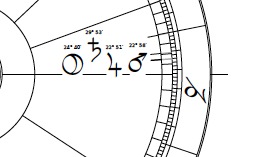
Astrology 101 – how to read a chart – ZODIAC – rotating 360 degree in a day – short clip – free content
The short clip is supposed to give you a visual understanding of the multitude of combinations in between the two principal axes (AC and MC) that the zodiac generates each day. This clip was created by combining 140 charts (every 10 minutes one chart).
What you see unfolding is a sped up rotation spanning a 24 hour period. You will see the zodiac completing a 360 degree rotation. The start is at about midnight, which is when the sun (the planet with the small circle and the dot in the center) is at the lowest point. This is called the IC – or midnight point. The sun is moving in clockwise rotation towards AC, the point of sunrise. From here it moves over the morning hours to the top of the chart to reach the MC, around midday. After that it moves downward towards the DC, which is the evening point. At midnight it returns to the IC, the midnight point from where it will start its daily journey all over again. Completing this daily 360 degree journey the sun travels through all twelve houses. As you can observe, the Zodiac “takes all the planets with it” on that rotational journey. What you can hardly notice, is that in addition to the planets moving by themselves, they are also gradually moving on Zodiac. Some planets move in the same direction, while others sometimes move counterclockwise for a while. Completing one 360 rotation (one day) the sun itself has moved by one degree as well. So everything is in motion and creates a unique time content for every moment and place.
What might strike you different is the perspective of how the planets are moving. We are used to presentations that usually depict a heliocentric perspective of the solar system. Heliocentric is understood as the sun being the center of our solar system and the planets are rotating around it on a circular path.
On the other hand, the classic chart of a horoscope is based on a geocentric perspective, earth being the center. Meaning the spectator is right on the surface of the earth and observes how the planets are rotating “around” the location where that person is positioned. The chart records where each of the planets are positioned in relationship to the place of the observer. The observer in this case would be an event or the birth chart of a person. Every chart is just one snapshot of a moment in time and place, which records the position of the planets for that very moment. Up to this point everything is pure astronomy, just the point of observation is different. The programme that is used to calculate my charts is even based on NASA findings and calculations.
2021 Copyright by Dirk Heinicke. All rights reserved